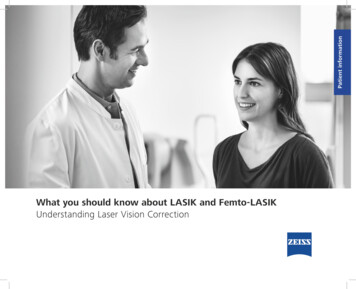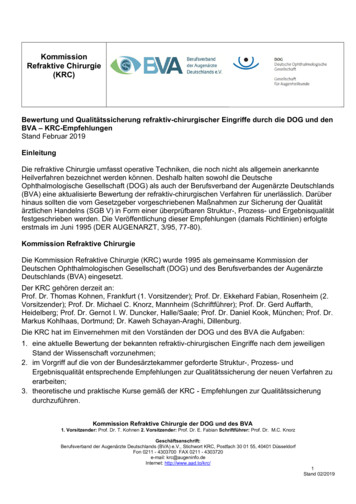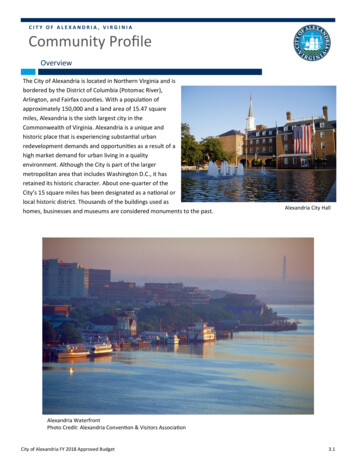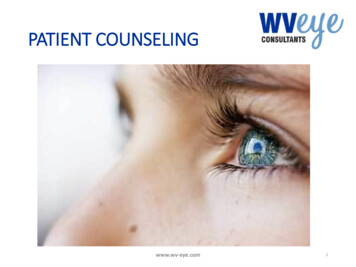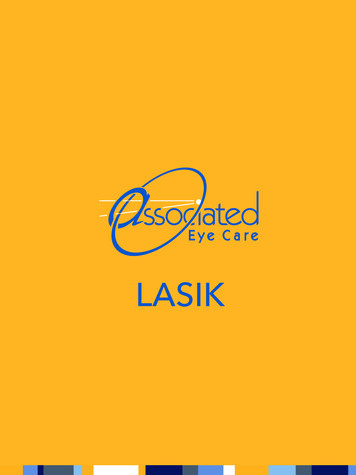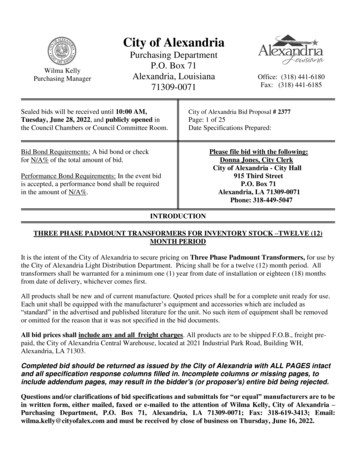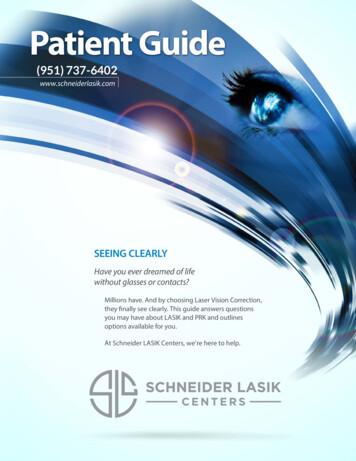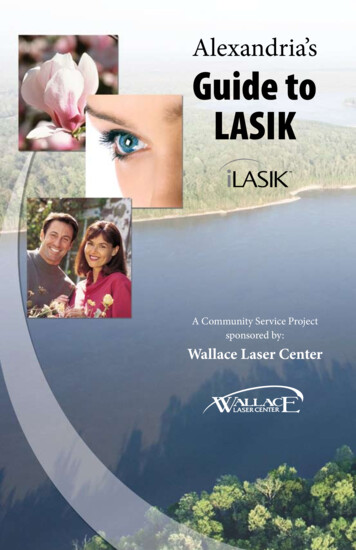
Transcription
Alexandria’sGuide toLASIKA Community Service Projectsponsored by:Wallace Laser Center
Your Guide To A Successful LASIK ProcedureThe word LASIK is actually an acronym for Laser Assisted In-Situ Keratomileusis.Thanks to advancements in safety, precision and diagnostics during the past decade, LASIKhas become the most popular vision correction procedure ever performed. It has beendeemed by the American Society of Cataract & Refractive Surgeons and the Eye SurgeryEducational Council to be a safe and effective treatment for a wide range of common visiondisorders, including myopia (nearsightedness), hyperopia (farsightedness), and astigmatism(a special form of nearsightedness or farsightedness). Since 1995, nearly three millionpeople in the United States have successfully undergone the LASIK procedure.With the help of the most advanced technology, CustomVue LASIK has made laservision correction more safe and accurate than ever before. CustomVue LASIK allowsdoctors to make a virtual ‘fingerprint of your eye’ using WaveFront aberrometry, whichallows surgeons to customize treatment plans for individual eyes. The result? A new level ofvisual excellence impossible to achieve with either glasses or contact lenses. In clinical trials,98% of patients achieved 20/20 vision or better 12 months following their CustomVue procedure.For the vast majority of patients, LASIK improves vision and reduces dependenceon prescription eyewear. However, as in any surgical procedure, there are inherent risks,complications, and side effects that can occur with LASIK. Therefore, it is essential thatcandidates considering this procedure are well informed and educated on both the benefitsand the risks of LASIK.The purpose of producing this educational guide is to help prospective patients makea more informed decision about improving their vision by reducing or eliminating theirdependence on corrective eyewear through LASIK. The information presented in this guideis educational in nature and is not intended to serve as a substitute for medical advice, norshould it replace the informed consent process provided by doctors prior to patients havingsurgery.Determining the Ideal Candidate for LASIKThe ideal candidate for LASIK should meet the following criteria:1. Be at least 18 years of age.2. Have a stable prescription for glasses or contacts for at least two years.3. Have adequate corneal thickness and pupil size for the procedure.4. Have naturally occurring myopia, hyperopia, and/or astigmatism.5. Have no medical disease or vision impairment that could reduce the effectivenessof the procedure.6. Be adequately informed of the benefits and risks of the procedure.7. Have a desire to reduce their dependence on corrective eyewear.8. Have reasonable expectations.Before choosing to have your LASIK procedure, be sure to discuss these criteriawith your eye care professional.
Results You Can Expect From LASIKAfter LASIK surgery, the majority of patients with low to moderate levels ofnearsightedness, farsightedness, and astigmatism achieve 20/20 vision or better. Thislevel of vision enables patients to pass their driver’s license test without glasses orcontacts and enables them to perform most of their normal daily activities. Manypatients – but not all – achieve 20/20 or their visual goal, depending in part on theirpreoperative, best-corrected visual acuity. Your postoperative goal will be determinedby your age and the general health of your eyes. Patients with high to severe levels ofnearsightedness, farsightedness, and astigmatism can still benefit greatly from LASIK,but they should discuss their special circumstances with the surgeon. If you do notachieve optimal results, a follow-up procedure – or enhancement – can be performedto further improve vision. Ask your surgeon if he or she maintains an active databaseof outcomes analysis.Postoperative Management and FeesFinal results from LASIK depend not only on the qualifications of the surgeonand the technology he or she uses to perform the procedure, but also on the patientfollowing all pre- and post-op instruction and steps. This includes the postoperativemanagement instruction that patients receive from the surgeon, technical staff, and/orco-managing doctor during the weeks and months following the procedure. Becausefees for LASIK vary greatly from center to center, it is important to discuss postoperative costs with the surgeon performing your procedure. Patients should ensure thatat least one full year of postoperative exams and follow-up visits are included in theglobal fee charged for the procedure. Some centers charge patients according to theirlevel of refractive error to help make LASIK seem more affordable. Be sure to go overspecific costs with your surgeon prior to undergoing the procedure.
The Surgeon/Patient RelationshipIn many of today’s large corporate LASIK centers, patient access to their actualsurgeon before and after their procedure is either limited or unavailable. Theopportunity to meet your surgeon prior to your day of surgery - and have him or herperform your preoperative examination - allows patients to better understand theirsurgeon’s philosophy of patient care and observe his or her “bedside manner.” It alsogives patients a great opportunity to have their surgeon address any final questionsor concerns they have prior to surgery. Discussions with the surgeon performing theprocedure should also include his or her results with patients who had a range ofcorrection similar to yours.
Conducting The Appropriate Pre-LASIK TestingTo help ensure the best possible result from LASIK, all candidates should undergoextensive preoperative testing to rule out possible conditions that may affect youroutcome. This special testing should include the following:1. WaveFront Diagnostics – using WaveFront aberrometry to measure the entire opticalsystem of the eye, WaveFront technology identifies and measures imperfections inthe eye many times more precisely than standard methods used for glasses orcontacts; this is the ultimate determining factor for LASIK candidacy.2. Corneal Topography – a computerized ‘topographical map’ that measures up to7000 locations on the corneal surface for possible irregularities. Patients withectasia (steepness in the lower part of the cornea) or keratoconus (bulging of thecornea) may not be considered ideal candidates.3. Pachymetry – technology that measures the thickness of the cornea to ensureadequate tissue is available for optimal results.4. Pathology Exam – a dilated examination by an Eye doctor to check for cataracts,glaucoma, retinal diseases and/or tears or holes, diabetes, AIDS, or herpes simplexinflammation that could slow the healing or impair the results.5. Pupilometry Testing – measures the size of your pupil in maximum darkness toanticipate halos, starbursts, glare, and ghosting from an abnormal pupil size orshape.6. Slit Lamp Exam – basic examination by an Eye doctor to check the general healthof the eye and check for irregularities in the cornea.7. Schirmer Tearing Test – a test to detect possible dry eye syndrome, which can beexacerbated by LASIK surgery.8. Refraction – testing to determine level of nearsightedness, farsightedness, andastigmatism under both non-dilated and dilated conditions.9. Vision Goal – the patient’s desired outcome is defined based on accumulatedinformation about his or her visual system.Be certain to ask your LASIK surgeon if all of the testing mentioned here will beincluded in your preoperative work-up prior to LASIK.
Finding The Right SurgeonYour results from LASIK will be directly related to the overall experience of yoursurgeon. To achieve optimal results from your LASIK procedure, seek a surgeon whois an active member of the American Society of Cataract and Refractive Surgeryand is certified & trained on the latest VISX technology. It is also important toselect a surgeon who carefully monitors his surgical outcomes (LASIK results) andmakes those available for patients. According to a study conducted by the AmericanSociety of Cataract and Refractive Surgery, the level of intraoperative complicationsfor experienced surgeons is 0.9% compared to a complication rate of 4.5% of lessexperienced surgeons. Continuity of postoperative care and surgeon availabilityfollowing LASIK is also critical for optimal results. Prior to undergoing the LASIKprocedure, determine who provides your pre- and postoperativecare, how much specific experience your surgeon or comanaging optometrist has, and where he or she hasreceived training.Take yourvisionto thenextlevel
Making LASIK safer:One of the major obstacles preventing most patients from enjoying thebenefits is their fear of the procedure. Statistics involved thousands ofpatients indicate that the more understanding and working knowledgea patient has of LASIK, the more capable he or she becomes in makingan informed and educational decision regarding vision correction. Thisincludes helping them overcome their basic fear of the procedure.Fortunately new technology now available in Alexandria is furtherhelping patients reduce their fear and anxiety of LASIK. LASIKinvolves making a thin protective flap in the cornea, then reshapingthe inner tissue using an Excimer laser. Traditionally, this protectiveflap was created using a hand-held mechanical instrument called amicrokeratome which contains a metal blade that slices into the cornea.Although relatively safe, the microkeratome can produce a rough andirregular corneal surface that can affect the quality of vision. Toeliminate the potential problems caused by a bladed cut, femtosecondlasers have added a tremendous level of safety and accuracy to flapcreation with over a million procedures preformed to date.The IntraLase femtosecond laser represents the next level ofexcellence in flap creation. Using its ultra-fast, tightly focused, lowenergy laser beam, microscopic bubbles are created at the precise depthwithin the cornea. This causes the layers of the cornea to separatethereby creating a LASIK flap of the desired thickness, size, orientationand location, unique to each patient’s needs. The bubbles created bythe IntraLase disappear soon after the flap is lifted, creating a smoothersurface and allowing the LASIK procedure to be performed.This tremendous level of control and customization makes LASIKsafer, speeds visual recovery, makes our patients more comfortable, andcontributes to better visual outcomes.The Right Operating EnvironmentFactors such as humidity levels and room temperature in a laserenvironment can affect LASIK results. Therefore, it is critical toensure your procedure is performed in a controlled, ‘medically-clean’environment, where conditions such as humidity, air quality, andtemperature are closely monitored and maintained. Best results will beachieved in ‘dedicated’ laser suites with proper air exchange and controlsthat have been designed specifically for LASIK and the type of lasertechnology in the laser center.
Reputation and ResearchChoosing a LASIK center with a proven reputation for leadingedge technology and uncompromised patient care will furtherenhance the overallLASIK experience. Unfortunately, many corporate anddiscount LASIK centers today frequently change surgical teamsand surgeons, making it difficult to maintain the highest standardsand continuity in quality patient care. Surgeons who are involvedin ongoing research and development are continually exposed tothe latest breakthroughs in technology and surgical techniqueslong before the average surgeon. For optimal LASIK results, haveyour procedure performed at a comprehensive eye care facilitywith an experienced refractive surgical team dedicated to research,technology, and complete patient satisfaction.In addition, ophthalmologists who provide “full service” surgical and general eye care can handle your needs now and into thefuture. Choosing such a surgical team gives you access to the mostup-to-date techniques and medical advances available today.A Community Service Project sponsored by1-800-New-Eyes4300 Parliament DriveAlexandria, LA 71303www.WallaceEyeSurgery.com
The word LASIK is actually an acronym for Laser Assisted In-Situ Keratomileusis. Thanks to advancements in safety, precision and diagnostics during the past decade, LASIK has become the most popular vision correction procedure ever performed. It has been deemed by the American Society of Cataract & Refractive Surgeons and the Eye Surgery

